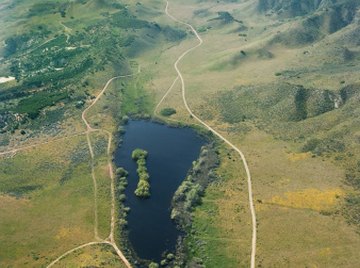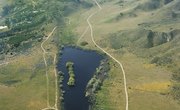
Earthquakes occur when two sections of rock within the Earth’s crust move against each other. The Earth’s crust and upper mantle, known collectively as the lithosphere, consists of a number of separate sections, or tectonic plates, in constant movement relative to each other. The forces propelling these plates are convection currents that rise from the Earth’s hot, molten core, through the plastic mantle and towards the lithosphere where they cool and fall back to the core. Earthquakes occur both around the boundaries of these plates and within them.
Stress
The movement of tectonic plates causes stress to build up on the boundaries of and within the plates. It deforms the crust through a process of crushing, stretching or uplifting. Stress builds up over years, decades, centuries, thousands or millions of years. As the stress exceeds the strength of the rock, the rock breaks.
Faults
A fault is the plane along which rocks break. When rocks move laterally relative to each other, they create a strike-slip fault. An example of this is the San Andreas Fault in California. When one piece of crust falls relative to another, this is a normal fault. Normal faults exist along the boundaries of rift valleys, such as Death Valley in California and the Rhine Valley in Germany. When one piece of crust moves over or under another, it creates a thrust fault. Thrust faults bound the entire Pacific Ocean Basin.
Rupture
Rupture is the area of rock breakage during an earthquake. On the ground, it appears like a fracture that moves along the length of a fault. A rupture 21 feet in length along 270 miles of the San Andreas Fault caused the 1906 San Francisco earthquake.
Propagation
Propagation is the movement of a rupture through the Earth. During the Feb 27, 2010 Maule earthquake in Chile, the rupture moved along the fault plane to the north, south and west at a speed of between 1 and 1.5 miles per second.
Ground Shaking
Rupture propagation disturbs neighboring rocks. This disturbance travels within the Earth to its surface and along its surface in waves of energy known as seismic waves. These arrive at the Earth’s surface in pulses, causing ground shaking and damage to buildings.
Liquefaction
Strong shaking of the soil along shorelines or river banks loosens grain cohesion and the structure of the soil. Lacking strength, the soil behaves like a liquid. Buildings sink in liquefied soil while buried pipelines and tanks float upwards as if by buoyancy. New Zealand’s second city, Christchurch, stands on an ancient river valley and drained swamp. Liquefaction during the Feb 22, 2011, earthquake in Christchurch rendered half the city and its suburbs uninhabitable.
References
Resources
About the Author
Based in London, Maria Kielmas worked in earthquake engineering and international petroleum exploration before entering journalism in 1986. She has written for the "Financial Times," "Barron's," "Christian Science Monitor," and "Rheinischer Merkur" as well as specialist publications on the energy and financial industries and the European, Middle Eastern, African, Asian and Latin American regions. She has a Bachelor of Science in physics and geology from Manchester University and a Master of Science in marine geotechnics from the University of Wales School of Ocean Sciences.
Photo Credits
Thinkstock/Comstock/Getty Images
